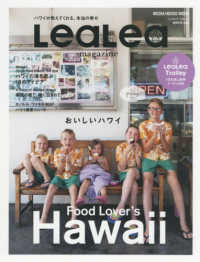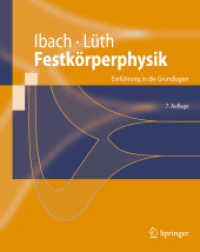- ホーム
- > 洋書
- > ドイツ書
- > Humanities, Arts & Music
- > Arts
- > interior decoration & design
Full Description
Why are pizzas round, and why are fish fingers rectangular? Why do we cut a cake one way and bread another way? "Food Design", which was published in 2005, gave the first answers to these questions. Now the dedicated authors present, "Food Design XL," the more comprehensive, larger and bilingual edition of their award-winning work. "Food Design XL" shows how shape, color, smell, consistency, consumption noises, production methods, history and stories influence food product design. After all, we consciously change the appearance of nature's edible offerings more than one thousand times a year, before every meal, by cutting, cooking, stirring or combining foods. The human will to design food sets apart from other living creatures. We have all been food designers for thousands of years. This is reason enough to whet the reader's appetite for this subject with this new XL-format bilingual edition. Warum sind Pizzas rund und Fischstäbchen rechteckig? Warum teilen wir die Torte anders als wir Brot schneiden? Auf diese und ähnliche Fragen gab das im Jahr 2005 erfolgreich lancierte und mit internationalen Preisen ausgezeichnete Buch "Food Design" bereits erste Antworten. Nun präsentieren die engagierten Autoren die an Umfang, Größe und Zweisprachigkeit zugenommene Maxi-Ausgabe. "Food Design XL" zeigt auf, wie Form, Farbe, Geruch, Konsistenz, Verzehrgeräusche, Herstellungstechnik, Geschichte und Geschichten das Design von Lebensmitteln beeinflussen. Denn mehr als eintausend Mal pro Jahr - vor jedem Essen - zerschneiden, zerkochen, verrühren oder kombinieren, also verändern wir bewusst das essbare Angebot der Natur. Der menschliche Wille, Essbares zu gestalten, unterscheidet uns von allen anderen Lebewesen. Seit tausenden von Jahren sind wir also alle Food-Designer. Grund genug, dieses Thema dem Leser im XL-Format und nun zweisprachig schmackhaft zu machen.
Contents
Einleitung.- Teufelshorn und Herrgottsb'scheißerl - Symbol, Täuschung und Entfremdung.- Baukästen und Werkzeuge.- Symbiose und essbare Hilfsmittel.- Knusperspaß und Farbenfreude Haptik, Geräusch und Farbe.- Spannung in Hülle und Fülle.- Das Zusammenspiel von Innen und Außen.- Die Lust am Teilen.- Vom Brechen, Schneiden und Portionieren.- Knusprig oder streichfähig.- Oberflächen und Konsistenzen.- Stapelbare Fische.- Herstellung und Transport.- Man ist, was man isst.- Phänomene des Zeitgeists.- Danksagung.- Literaturverzeichnis. Introduction. - Devil's Horn and "Hergottsb'scheisserl" - Symbol, Fake & Estrangement. - Construction Kit and Tools -Symbiosis and eatable aids. - Enjoy the Crunchy and Coloured (Fun Food). - Surface feel, Sound and Colour. - Suspense in Abundance. - The Cooperation between Inside & Outside. - Delight of Sharing. - How to crack, cut and divide. - Crispy or Smooth. - Surface & Consistency. - Stackable Fish. - Production & Transportation. - You are what you eat. - Trends and Phenomenon of the Zeitgeist. - Acknowledgment








